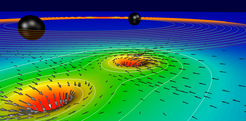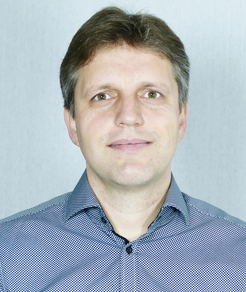How to detect colliding black holes
Friedrich Wilhelm Bessel Research Award for Prof. Harald Pfeiffer
On March 18, 2016, Harald Pfeiffer, Associate Professor at the Canadian Institute for Theoretical Physics, Toronto, will be honoured with a Bessel Award of the Humboldt Foundation. The award will allow him to stay at the Max Planck Institute for Gravitational Physics (Albert Einstein Institute, AEI) in Potsdam where he will work closely with Prof. Buonanno’s division on the prediction of the gravitational waves that are generated when black holes collide.
Albert Einstein predicted the existence of gravitational waves 100 years ago. These tiny ripples in space and time are generated when black holes or neutron stars collide.
In September 2015, the LIGO observatories detected gravitational waves for the very first time on Earth. The waves they catched from space originated from two black holes that merged 1.3 billion light years ago in a distant galaxy. Finding the tiny waves, as well as deciphering what was seen, requires detailed knowledge of the expected signals.
“We are looking for the needle in the haystack because the signals are buried in the noise”, Pfeiffer explains. “But if we know how the needle looks like we have a better chance to find it.” Pfeiffer’s research on the construction of waveform models for gravitational-wave detectors focuses on numerical simulations – he solves Einstein’s equations on supercomputers. Together with his collaborators he is not only looking for one single needle, but for lots of different looking needles: binaries of black holes and/or neutron stars of different masses and spins that generate different looking signals. Pfeiffer’s research not only helps us locate black holes in the Universe and determine their size, but his calculations also teach us how space-time behaves when it is warped by black holes.

Pfeiffer has already arrived at AEI and will stay until July, 2016. “It is a great honour to have been selected for a Bessel Award of the Humboldt Foundation” says Pfeiffer. “I am excited about the possibility to stay for an extended period at the Albert Einstein Institute, which combines world-class excellence in science with a welcoming and friendly atmosphere. During my stay I will study jointly with Prof. Buonanno’s division, the collision of two black holes to enable gravitational wave detectors to measure properties of black holes, and to decide whether Einstein’s theory of General Relativity is correct.”
Helmut Schwarz, President of the Humboldt Foundation, will present the award at a special ceremony being held in Bamberg on March 18 at the 44th Symposium for Research Award winners.

Harald Pfeiffer (born in 1974) studied physics in Bayreuth, Germany, and Cambridge, UK, before earning his PhD in 2003 at Cornell University, Ithaca, USA. The American Physical Society awarded him the Nicholas Metropolis Award for Outstanding Thesis Work in Computational Physics. After postdoctoral research at the California Institute of Technology in Pasadena he was awarded the Canada Research Chair in Numerical Relativity and Gravitational Wave Astrophysics and joined the faculty of the Canadian Institute for Theoretical Physics in Toronto in 2009. Pfeiffer is a Fellow of the Canadian Institute for Advanced Research; he received the Ontario Early Researcher Award in 2014 and became Associate Professor at the Canadian Institute for Theoretical Physics in the same year.
Friedrich Wilhelm Bessel Research Award
The Humboldt Foundation grants around 20 Friedrich Wilhelm Bessel Research Awards annually to internationally renowned scientists and scholars from abroad. Award winners are honoured for their outstanding research record and invited to spend a period of up to one year cooperating on a long-term research project with specialist colleagues at a research institution in Germany. The award is valued at €45,000.
Background: Modeling the sources of gravitational waves
When compact objects with large masses like black holes or neutron stars move at speeds close to the speed of light, they emit characteristic gravitational waves. Ground-based interferometric detectors across the world are searching for these waves, to confirm Einstein’s theory of relativity and to learn about black holes, neutron stars and other processes in the universe that generate gravitational waves. But observing them is not a trivial task: The gravitational-wave signals that we expect are faint and buried within the noise of the detectors. To tell noise and gravitational waves apart the plausible gravitational waveforms from astrophysical sources must be predicted. Pfeiffer is researching gravitational wave prediction through numerical simulations on supercomputers such as the AEI’s Datura compute cluster. He and his collaborators developed the Spectral Einstein Code (SpEC), a flexible infrastructure for solving partial differential equations. The main application area of SpEC lies in simulating compact binary objects. SpEC is one of the most accurate and efficient codes to compute the gravitational waveforms for inspiraling and coalescing binary black holes. These accurate waveforms serve as templates for the search in the detector data.













